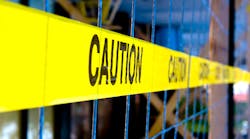When Harvey, a technician for an HVAC contractor, started his day, he had no idea what was in store for him. He was on his way to carry out some routine maintenance on a main air supply fan in a mechanical room located at a large, 20-yr old commercial office building.
When he arrived at the office, he met Bill, a building maintenance worker. Together, they went up to the fan room on the ninth floor of a 10-story building. Most of this floor served building services. In the fan room were several air system distribution fans, dampers, motors, motor controls, and the main air supply fan, which was powered by a motor rated 125 hp, 460V.
Power to the fan motor was supplied through a 200A fused-disconnect switch, which in turn, supplied a Size 5 across-the-line motor controller. After describing the electrical and mechanical arrangement of the installation, Bill put the fan disconnect in the OFF position, deenergizing the system.
The fan motor controller was installed adjacent to the disconnect on a post. On the door of the controller was a RUN-OFF-AUTO selector switch. Harvey turned this switch from the AUTO to the OFF position. As Harvey began his maintenance routine, starting with cleaning of the fan blades, Bill left the fan room and returned to his workshop on the eighth floor.
After the fan was cleaned, Harvey's normal procedure was to rotate the fan blades so he could apply grease to the bearings as the fan slowly rotated. He switched the fan disconnect to the ON position and walked to the front of the contactor enclosure so that he could operate the control switch. As he moved the control switch from the OFF to RUN position, an explosion occurred inside the controller enclosure. The enclosure door seal ruptured, allowing hot gases to blast out. Unfortunately, Harvey was standing in front of the motor-control enclosure, directly in the path of the hot gases. He received first-and second-degree burns to his face and hands.
A muffled blast
At about the same time as the controller enclosure explosion was occurring in the fan room, Bill, the building maintenance worker on the eighth floor below, noticed the lights flicker and heard a muffled blast apparently coming from the fan room. As he would later describe the situation, he realized Harvey, the HVAC technician, was working on the fan and something must have malfunctioned. Therefore, he immediately went to a 480/277V panelboard on the 8th floor and attempted to turn off the 225A molded-case circuit breaker that supplied power to the fan. This was a normal procedure, but in this instance, an unfortunate one because a second calamity occurred!
As he moved the circuit-breaker handle from the ON to the OFF position, the circuit breaker exploded and an electrical fault occurred in the panelboard. This catastrophe caused hot gases and molten metal particles to be propelled towards him. He suffered minor burns to his hands and arms.
Both injured workers were taken to the hospital, treated, and released the same day. Fortunately, both workers have recovered and are working at their respective jobs.
What happened?
To determine the cause of this accident, the HVAC contractor's liability insurance company called our forensic engineering firm. A forensic engineer specializes in applying engineering education, specialized training and experience to assist insurance adjusters and attorneys in determining the circumstances surrounding equipment or system failures.
Our investigation began with an inspection of the building air supply fan electrical equipment and related power distribution systems. The damaged fan-motor contactor, it's controller enclosure, and the damaged panelboard were thoroughly inspected. Because it was important to get the office building up and running as soon as possible, an electrical contractor was called to replace the main air supply fan, related damaged components, and install a new panelboard. The new disconnect and motor controller were installed on a post in a manner very similar to the original installation.
Our next step was to obtain information from all related personnel and pertinent records. We acquired all available data regarding the history and operation of the fan system and the building electrical distribution system. We gathered as much information as possible, including the type of equipment, age, prior maintenance, and history of operating problems (if any) of all equipment.
Recorded statements from the two injured workers and other persons having knowledge relative to the accident had been obtained by the insurance adjuster soon after the accident. These statements were reviewed. Often times, however, technical information needed is not covered during the adjuster interview because the insurance adjuster does not understand the technical aspects of the accident. As a result, we then further interview pertinent personnel, and we may need to contact various manufacturers, vendors, or installers to obtain the necessary technical information.
Our next task is to perform laboratory examination of the damaged equipment. In this case, the distribution panelboard was examined first. The panelboard sustained significant arc-melt damage from the electrical fault. The fault had propagated from the failed circuit breaker to the vertical bus bars creating phase-to-phase and phase-to-ground faults. The circuit breaker that supplied power to the supply fan motor was disintegrated. From the arc-melt damage patterns found on the panelboard busbars, we were able to tell that the fault that caused the second explosion at the panelboard originated at the air supply fan motor circuit breaker in the panelboard. This was because the circuit breaker had essentially vaporized and related busbars in the panel were warped out shape.
The air supply fan motor controller enclosure and its main contactor were then examined. After initial photographic documentation, the main contactor was removed from the controller assembly, disassembled and the coil tested by applying 120V to its leads. The coil operated properly. In attempting to move the contacts, however, we found that the contactor movable contacts were badly damaged and would not properly operate.
Next, we observed that the arc-chute cover had not been installed on the contactor. Actually, during our initial inspection, the arc chute was found on the fan room floor about 10 ft from the controller enclosure and was collected as evidence. We examined the arc-chute and its mating parts, and found that the cover had not been in place on the contactor at the time of the accident. This was apparent because it had only minimal darkened markings.
Then, we inspected the motor-controller control switch. We made resistance continuity measurements to determine if the switch operated properly and we checked it for proper operation. We found that when the switch was moved from the OFF to RUN position, there was abnormal mechanical restriction of motion. The switch was carefully disassembled and we noted that the operating cam mechanism of the switch was broken.
How did it happen?
Analysis of the available information including site investigation, interviews, and laboratory examination and testing allowed us to conclude that the fan motor contactor probably developed a phase-to-phase fault due to abnormal operation when Harvey, the HVAC technician, attempted to manually start the fan. As a result of the broken cam, the contactor control switch probably operated intermittently and rapidly, and caused the contactor to chatter. Without the arc-chute in place on the contactor, a phase-to-phase fault developed as ozone was created by the continuous arcing at the contactor contacts.
Excessive short circuit current
It's very important to note that the damaged panelboard had a short-circuit rating of 14,000A. According to the city engineer, the building power distribution system short-circuit availability was approximately 22,000A or more at the panelboard. Therefore, when the arcing fault developed at the motor controller, the short-circuit capability of the panelboard circuit breaker was exceeded, and the circuit breaker could not safely interrupt the fault. Therefore, the breaker exploded, resulting in a fault that severely damaged the panelboard. The panelboard arcing fault was cleared by the main distribution board fuses located in the basement.
What can be learned?
What can be learned from a review of the circumstances that existed prior to and at the time of the accident? First, the power distribution system's available short-circuit current exceeded the rating of the panelboard. Apparently, expansion of the electrical system and an increase in system short-circuit availability from the utility had occurred in recent years and no one had noticed. Consideration had not been given to existing equipment ratings and upgrading of components had been neglected.
Second, prior maintenance to the air supply fan motor contactor was improper because the "tight" operation of control switch had not been corrected. In addition to this, arc chute was not replaced on the contactor.
Lastly and possibly most importantly, the HVAC technician was standing in front of the motor controller enclosure as he operated the control switch. The failure of the control switch was an abnormal event that could have happened at any time. However, equipment design that allows placement of a control switch on the cover of a motor controller enclosure normally places the operator directly in front of the enclosure. In this incident, had the control switch been located on a separate control panel away from the contactor enclosure, the technician most probably would not have been injured. Or, if he had been able to stand well off to one side of the controller, his injuries might have been minimized.
Bill, the building maintenance worker who had attempted to switch the circuit breaker to the OFF position, was also standing in front of the panelboard as he operated the circuit breaker. Standing directly in front of the device placed him in jeopardy and he received burn injuries when the explosion occurred. Proper work practices must be used all the time so that it becomes a habit. Most of us stand and look at the switching device as it operates. However, the building maintenance worker and the HVAC technician probably will never operate a switch or circuit breaker again while standing directly in front of it.
The next time you operate an electrical device, think about this accident and don't let it happen to you.
Michael Foley is a forensic electrical engineer for Technical Consultants Group, Ltd. in Denver.



